
Discover the 5 most cost-effective methods to fence your yard for dogs, from temporary barriers to DIY installs. Get tips for affordable materials and smart containment strategies. So, without further ado let’s start with Top 5 cheapest way to fence a yard for dogs.
Assess Your Fencing Needs and Yard Layout
Consider size of yard and fence height needed to contain dog

The first step in choosing cost-effective fencing for your dog is determining what size fence you need. Take measurements of your full yard as well as just the areas your dog will have access to. You’ll need to contain your pup within the fenced area, so make sure to consider both their current and fully grown size. Small dogs like Dachshunds may only need a 3 foot fence, while large dogs like Great Danes require 5-6 feet. Brachycephalic breeds like Pugs are prone to overheating and struggling with exercise, so a smaller containment area is fine. Energetic herding dogs such as Border Collies will need ample room to run safely.
Factor in your dog’s jumping prowess too. Athletic canines like Jack Russell Terriers can leap surprising heights – up to 5 feet! Australian Shepherds too are champion jumpers. A taller privacy fence may be a smart investment if you have a canine pole-vaulter. Digging tendencies are also important. Short fencing will suffice for low-digging dogs, but escape artist breeds like Siberian Huskies will require digging barriers like concrete landscaping borders dug deep under the fence line or laying chicken wire at the base.
Pro tip: Don’t forget to measure any gates or entries! Double check the height on those matches your fence line. Gates should be self-closing and securable.
Factor in goals (privacy, security, purely keeping dog in yard)
Keep in mind why you want a fence in addition to confining your pooch. Is boosting privacy from neighbors or blocking road noise a priority? Do you need enhanced security from trespassers? These factors help determine optimal fence height and material. For instance, a 6 foot solid wood privacy fence will seclude your yard best. A lower wire mesh fence works fine just for a dog barrier but not privacy.
If aesthetics are important, you’ll want fencing that looks clean, refined or fits your home style versus a basic chain link dog run. Home value may also influence choices – quality wood or ornamental metal raises curb appeal over DIY pallet fencing. Consider view too – do you want an unobstructed view from patio to garden? Then skip a privacy fence in favor of short deck railing topped with chicken wire. Identify your must-haves so you can focus spending on essential features rather than over-improving.
Decide on fencing material and amount needed based on layout
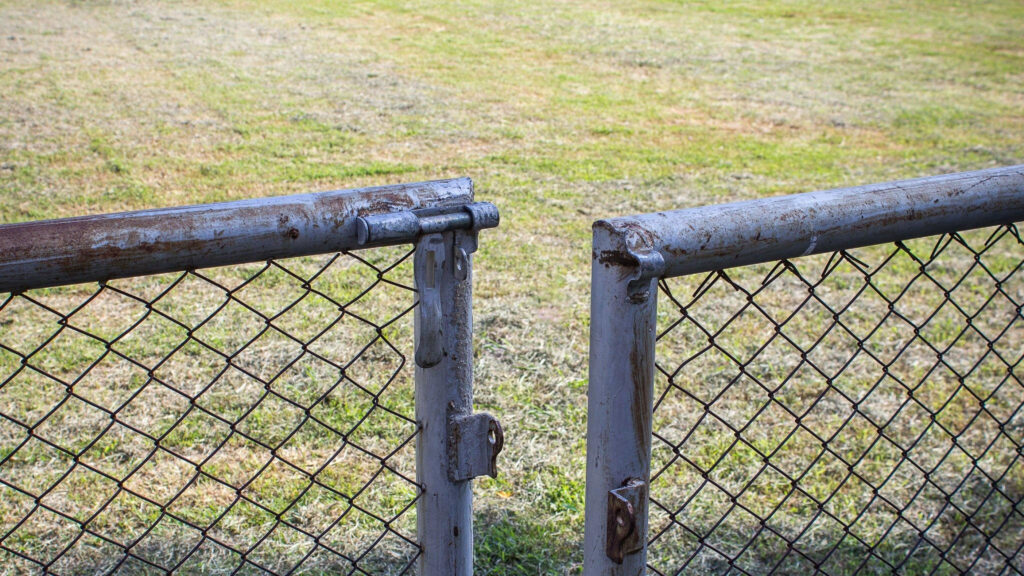
Crunch the numbers on materials needed according to your yard’s boundaries. Measure the perimeter and any dividers like between front and back. Having an odd shaped space? Break out the old geometry lessons to calculate triangles, rectangles and pi r squared for circles. Account for gates, corners and posts needing extra material. Sketch it out on paper to visualize.
Weave terrain into calculations – hills require longer spans while low spots may flood, requiring specialty wet-proof materials. How does the land slope? Steep inclines will render short fences ineffective as dogs can easily jump an angled lower side. Level yards are the most DIY friendly and economical to fence.
Soil quality factors in too. Loose, sandy soil makes setting stable posts difficult compared to firm clay. Pre-drilling holes and using extra-long posts helps when dealing with loose dirt. Rocky ground is also challenging for securing posts but can provide natural divisions like boulders across a hillside.
In the end, measure twice and buy once when estimating fencing needs! It’s a woof job measuring huge yards but precise calculations mean you get just the right amount of affordable fencing to contain your pup.
Explore Low-Cost Temporary Fencing Options
Installing a permanent fence for your dog can be pricey, especially if you have a large yard. Luckily, there are some budget-friendly temporary fencing options to contain your canine until you can save up for pricier permanent fencing. Let’s dig into some temporary fencing possibilities for thrifty dog owners.
Top 5 cheapest way to fence a yard for dogs
Plastic Mesh Fencing Rolls
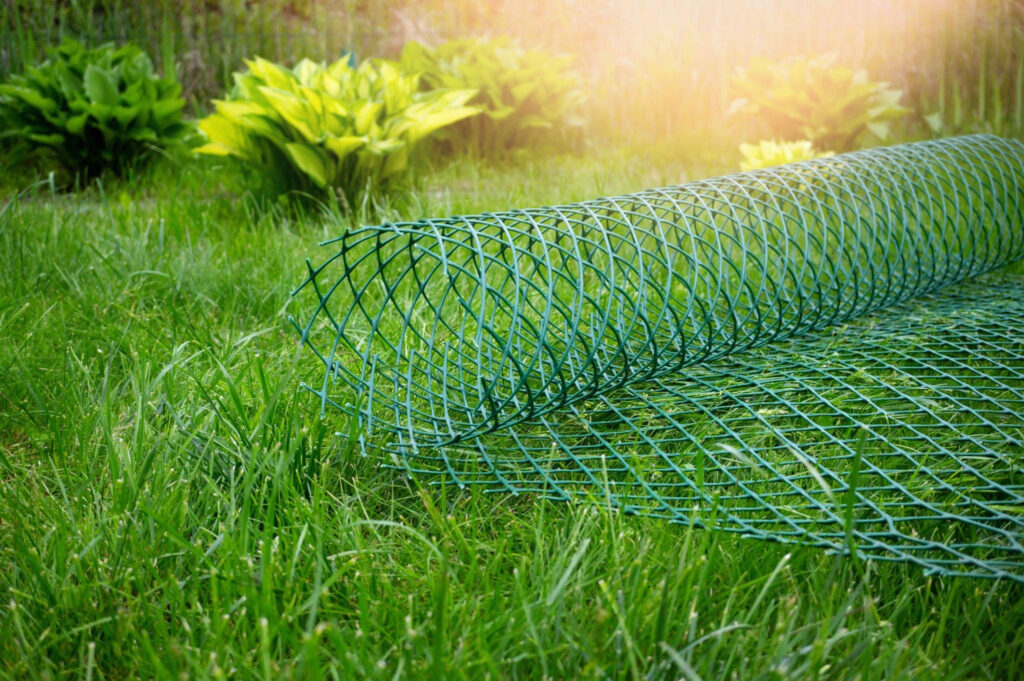
Plastic mesh or netting sold in rolls is an easily installable and affordable temporary fencing choice. The heavyweight polyethylene material comes in heights from 2 to 6 feet. This one of Top 5 cheapest way to fence a yard for dogs. Rolls are sold in various lengths, usually 50 to 200 foot sections.
Pros:
- Lightweight, portable, and easy to set up alone. No heavy wood or metal posts required.
- Can be installed in any layout since rolls are flexible. Good for oddly shaped yards.
- Mesh holes allow visibility and breeze while still containing pets.
- At 2-3 cents per linear foot, very budget friendly.
Cons:
- Not the most durable long-term, can sag over time without proper tension.
- Dogs may chew through the plastic if bored and unattended.
- Can be tipped over if not properly secured to ground.
To install, attach the fencing to trees or structural posts using zip ties, then stake into the ground every 2-3 feet with U-shaped landscape spikes. Check periodically that stakes remain firmly embedded. For very strong dogs, consider rolling a layer of chicken wire along the base which they can’t dig under. Move and reinstall the mesh fencing anytime to rotate your pup’s play area.
Wooden Stake Fencing
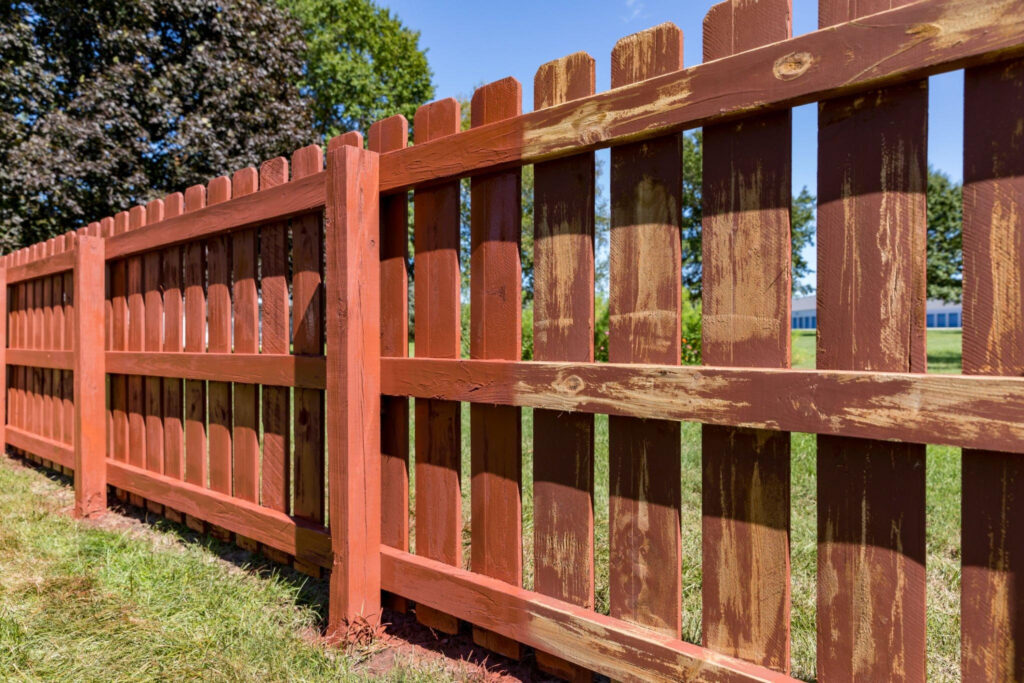
Don’t want to deal with concrete or metal posts? Another temporary option is using wooden stakes – similar to picket fencing but with taller, more closely spaced wooden slats. Standard heights are 4 to 6 feet.
Pros:
- Made from inexpensive wood, usually pine or cedar.
- Can be moved and reconfigured easily compared to permanent wood fencing.
- Installable with basic tools like a mallet.
Cons:
- Not as durable long-term since wood deteriorates faster.
- Need to check for slats becoming loose and re-pound stakes frequently.
- Dogs may chew wooden slats if bored.
Drive stakes at least 12 inches deep and space every 2-3 feet. Attach slats or fencing boards with galvanized nails or staples. For very motivated escape artists, a rolled chicken wire base can be attached. An advantage over plastic mesh is that wooden stake fencing can have a more decorative, finished look.
T-Post Fencing with Wire Mesh
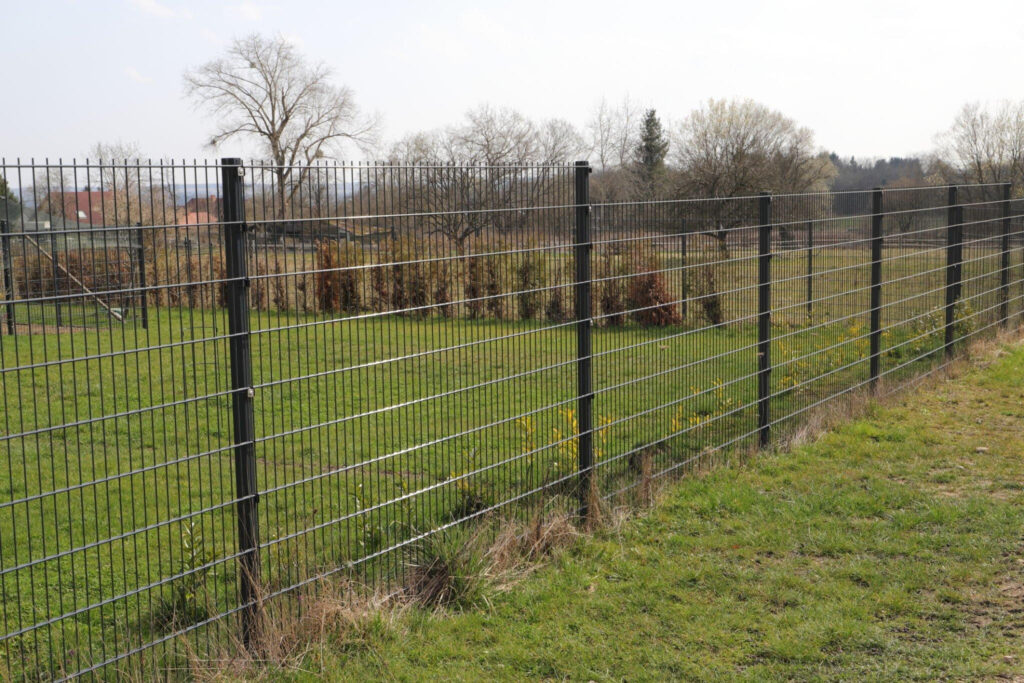
This affordable option uses heavy-duty T-shaped metal posts (also called t-posts) anchored into the ground with wire fencing stretched between and is one of the Top 5 cheapest way to fence a yard for dogs. The posts provide rigidity while the wire adds security that dogs can’t squeeze through.
Pros:
- At $3-5 each, T-posts are an economical alternative to wood.
- Set up is quick with just a post pounder tool.
- Wire mesh fencing is sold in various sizes and styles.
Cons:
- Still need tools to properly install t-posts.
- Not as decorative as wood or ornamental metal fencing options.
For best results, use high tensile strength 14 gauge T-posts spaced every 8-10 feet. Stretch 4 feet tall 14 gauge wire fencing between posts, pulling the mesh taut. Use heavy zip ties to attach the wire securely to posts. Add a tension wire along the base for extra reinforcement. This fencing stands up well to children and pets until you can install a permanent solution.
Snow Fencing
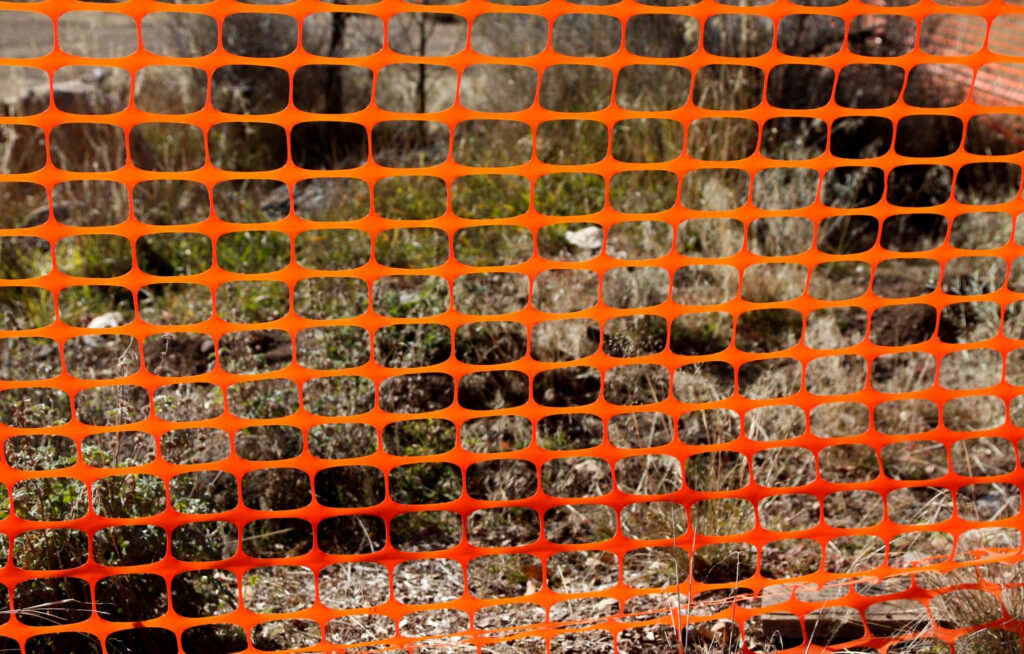
Confine your dog in winter style with plastic snow fencing! might not sound so 5 cheapest way to fence a yard for dogs. This temporary option is similar to plastic mesh but features taller fence heights from 4 to 8 feet.
Pros:
- Lightweight and portable to move around yard.
- More privacy and wind/debris blocking than short mesh.
- Very inexpensive at 5-8 cents per linear foot.
Cons:
- Durability is limited – not intended for permanent use.
- Must be properly staked and reinforced to avoid blowing over.
- Dogs might chew through plastic if unattended.
Install by staking down corner posts deeply, then attaching fencing using zip ties. Reinforce stretches longer than 10 feet with T-posts. Check that top edge leans slightly inward so fencing doesn’t flip up on windy days. While it won’t win “best in show”, snow fencing is an easy dog corralling solution for under $100.
So explore these temporary containment options if you need to fence your yard pronto before investing in permanent materials. Just be sure to frequently check fencing stability and reinforce as needed until you’re ready for a forever fence!
Install an Inexpensive Permanent Fence
Temporary fencing can work in a pinch, but for reliable long-term containment, a permanent fence is best for man’s best friend. Luckily, there are several budget-friendly permanent fencing styles to give your dog durability without breaking the bank.
Chain Link Fencing

Chain link is a wire mesh fencing anchored to metal posts. It’s an affordable go-to for kennels and yards needing a no-frills barrier.
Pros:
- Cost effective at $3-6 per linear foot.
- Simple DIY installation.
- See-through view and ventilation.
Cons:
- Not the most decorative look.
- Needs occasional maintenance to re-stretch sagging sections.
- Dogs can dig under if bottom edge not secured.
First set galvanized steel posts 8-10 feet apart using concrete. Top with railings for rigidity. Use 11-14 gauge vinyl coated wire and attach to posts with metal bands. For tamper proofing, bend base toward ground or dig perimeter wire into a 6 inch trench. Gates should have metal frames on both sides for reinforcement. Though basic, chain link is cost efficient and confines pets securely long term.
Welded Wire Fencing

Similar to chain link but without metal post framing, welded wire fencing offers another no-frills choice. Sturdy 14 gauge steel wire is welded into square grids.
Pros:
- Very economical at only $0.50-2 per foot.
- Easy DIY installation right into ground or attached to posts.
- Strong and secure containment.
Cons:
- Needs re-securing over time as wire loosens.
- Can develop rust without galvanized coating.
- Not aesthetically pleasing.
For simplest installation, use landscape spikes to secure fencing right into soil. For longevity, sink 4×4 wood posts 8 feet apart and staple wire to them. Bend bottom edge under soil or dig a border trench for determined diggers. Though institutional looking, welded wire is extremely cost-effective for safe confinement and one of the main 5 cheapest way to fence a yard for dogs.
Wood Pallet Fencing
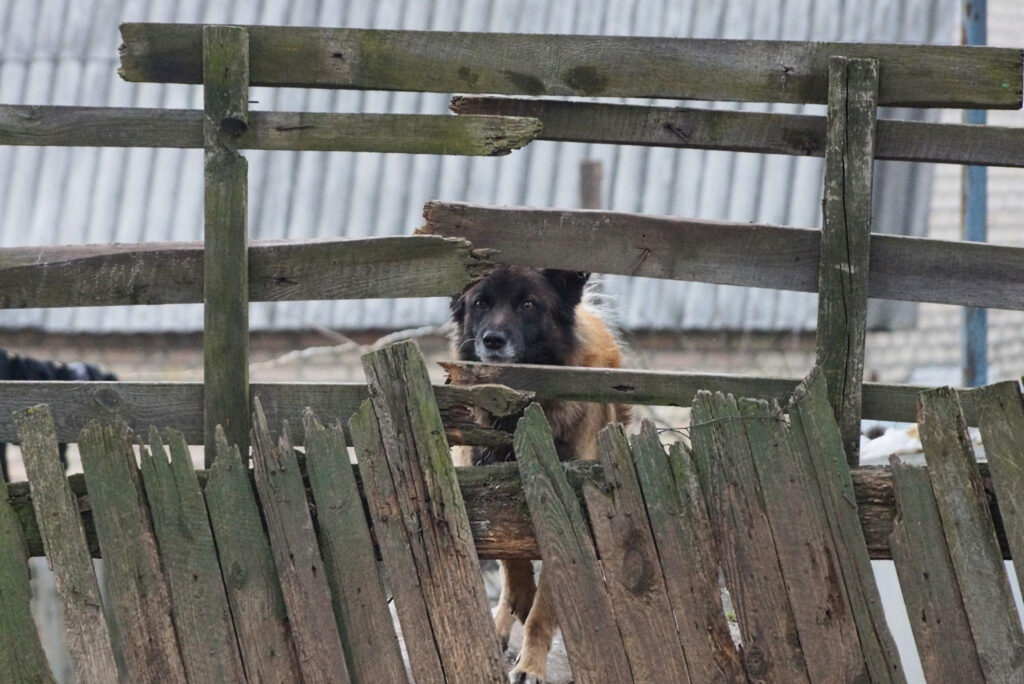
Upcycle shipping pallets into a rustic, budget-friendly picket fence. This style has surged in popularity on DIY blogs and Pinterest.
Pros:
- Made from free recycled pallets, only cost is hardware.
- Customizable with stains and decorative wood appliques.
- Installs with basic tools and skills.
Cons:
- Not as durable long term as pressure treated wood.
- Pallets can harbor bugs, mold or chemicals. Need to vet source.
- Limited privacy due to gaps between slats.
Sourcing pallets for free from retailers requires checking there are no chemicals stamped like fumigants or insecticides. Avoid warped or rotten boards. Use a post hole digger for 4×4 posts 8 feet apart. Attach pallets with galvanized screws, nails or staples. Consider sandwiching thinner pallets between decorative wood boards attached to posts for a finished look. Seal with exterior stain or paint for weatherproofing. Pallets provide cheap DIY security for Fido!
Live Fencing with Shrubs or Trees
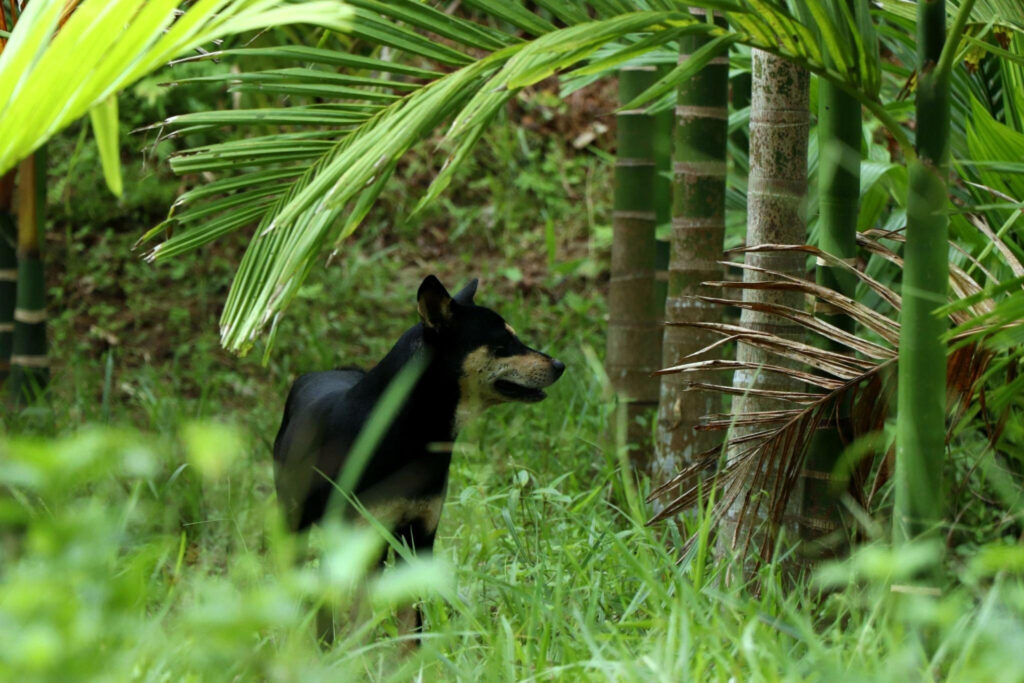
If you have the space and patience, grow your fencing over time using hedges, shrubs or trees. Evergreen varieties provide year-round coverage.
Pros:
- Very low cost over time compared to conventional fencing.
- Provides security plus wildlife food and habitat.
- Natural aesthetic and increased privacy.
Cons:
- Takes years to fully establish barrier coverage.
- Requires watering and pruning upkeep.
- Dogs may damage new plantings.
Choose native, fast growing plants like laurels, hollies, arborvitae, hemlock, roses, forsythia, blackberries or stone fruits. Space approximately 3 feet apart for best coverage. Install wire fencing or rows of willow cuttings around the perimeter until plants thicken up. Be sure to train dogs to avoid chewing or eliminating on your living fence! Though slow growing, a living fence can be incredibly cost effective.
Your dog will appreciate one of these permanent yet purse-friendly fences. Just monitor for diggers and climbers, providing fortifications like wire mesh skirting or angled toppers. Though not beauties, inexpensive permanent fences safely confine your pet.
Save on Costs by Opting for a Partial Fence
Fencing your entire yard or property perimeter can be overkill for just containing man’s best friend. Here are ways to save substantially by installing only partial fencing customized to your pup.
Fence just the backyard instead of entire property
Unless your dog will roam acres of land, fencing likely only needs to enclose the backyard where they play and potty.
A backyard dog fence spans a much smaller area compared to frontage on multiple sides. Even medium lots may only need 100 feet of backyard fencing versus 500+ feet for the full perimeter. That saves big time on material costs.
This strategy works best if your home separates the backyard from the front. Close off any side gates allowing access. Make sure fencing complements overall home aesthetics since it will be visible. A partial backyard fence level promotes security compared to roadside exposure.
Dogs with good recall can enjoy the front yard on leashed walks without needing to fence off the entire premises. Retriever and gun dog breeds like Golden Retrievers and German Shorthaired Pointers tend to have excellent obedience. Herding breeds like Collies and Shepherds also respond well off leash with proper training.
Of course, tiny toy breeds under 10 pounds or willful terriers are prone to taking off after squirrels, so know your dog’s personality! High prey drive dogs like Huskies should only be leash walked or fully fenced. But even many rambunctious dogs only really need access to a backyard space day-to-day.
Fence just the perimeter, not between yards
For large properties, look at whether your dog needs access to all areas. Fencing just the full perimeter can save on internal dividing.
Say you have acres of land but your dog mainly stays near the house. Run fencing around the rear, sides and front, enclosing just a few acres they actually use. There’s no need to bisect the entire expanse of land, just focus on perimetering your dog’s play zone.
This approach contains your pet while allowing wildlife corridors and saving enormously on fencing costs. Perimeter fencing also retains the open feel of the land versus chopping it up into mini parcels.
This strategy works best for mellow dogs unlikely to roam far with proper attention and exercise. Know your pet’s personality – hunting dogs like Beagles are apt to follow scents for miles and need larger contained areas. But even active breeds often stick closer to home than you’d think!
Fence only areas your dog has access to
Sometimes selective fencing of entry points suffices over enclosing entire swathes of land.
For example, if your home has a porch or deck, simply fence off the stairs. Gates can be added where humans need to access. The elevation change deters most dogs from jumping off. Fencing just porch/deck stairs cuts way down on materials needed versus wrapping the entire ground perimeter.
Similarly, fencing side gates and holes in fences leading to front yards can corral dogs without huge investments. Close off temptation points and doggie doors they can sneak through versus miles of fence construction.
When assessing your unique property, get creative with limiting access instead of defaulting to maximal fencing. Think like a dog – what are the key areas they really want to access for explorations? Stopping your pet at those strategical “choke points” eliminates chasing them across acres of land.
With smart planning, partial fencing options keep your pet safely contained and costs down. Know your dog’s habits and customize the fence layout from there. Saving major money is paws-ible for dog fences with selective installations!
Reduce Expenses through DIY Installation
Installing fencing yourself rather than hiring pros can yield huge savings. With proper planning, rental equipment, help from friends and online tutorials, you can DIY fence your yard for dogs.
Rent or borrow tools instead of hiring contractors
Specialized power tools like post hole diggers, hammer drills, nail guns and saws are necessities for fencing projects. Purchasing these can be pricey, especially for one-time use. Luckily, many home improvement stores like Home Depot and Lowes allow tool rentals for a daily or weekly fee.
Comparing costs, a 1-day rental of a post hole digger averages $40-60 versus buying one for $150-300. A power auger runs $100-150 per day – still spendy but way less than their $500+ purchase price. Nail guns rent for $25-50 depending on power needed. Factor these rental fees into your budget instead of thousands on contractor labor.
If you have handy friends or family, ask around to borrow. Many avid DIYers already own power tools and are happy to offset their costs through sharing. You may need to trade a case of beer or promise of reciprocation, but tool sharing can be a win-win.
Pro tip: Reserve rentals well in advance for popular tools during peak seasons. Don’t get stuck without a power auger on fence building day if they’re all checked out!
Use handyman skills and recruit help from friends
Completing a big fencing project solo can be daunting. Get free labor by hosting fence building parties and making it social. Pizza, beer and music keep the mood light while friends help dig holes and nail boards.
Most DIYers can handle straightforward installations like pounding corner posts and attaching wooden or wire fencing. Detailed technical steps like mixing & pouring concrete footings may require guidance though. Study up with how-to videos beforehand.
For mortar work, see if any buds have prior masonry or tile experience to walk you through mixing techniques.same goes for perfectly leveling and plumbing posts. Use friends with carpentry skills for building sturdy gates from scratch.
Don’t risk injury alone hefting massive fence panels either. Recruit a crew of 4-5 buddies to safely lift and maneuver into place, then celebrate your collective handiwork after! Friendly fence raising parties can cut thousands off labor costs.
Follow online guides and videos for DIY fencing
The internet offers a wealth of free fencing tutorials at your fingertips. Here are go-to resources:
- YouTube – Search “How to install (your fence type)” to find step-by-step video walkthroughs. Watch a few to compare techniques.
- DIY Network – This website has detailed guides with lists of tools and materials needed for every fencing scenario.
- Manufacturer websites – Many fencing brand sites like Home Depot have installation instructions for their products.
- DIY chat forums – Join communities of DIYers and ask specific questions to your project for experiential advice.
Study materials available for your exact fence type and terrain. Absorb key steps before kicking off so there are no mid-project knowledge gaps. Having an expert video on hand as you work helps ensure proper techniques.
Pro tip: Jot down measurements and diagrams in a notebook for easy reference. You won’t want to pause videos constantly during hands-on work.
Take advantage of fencing sales at home improvement stores
Big box home improvement retailers like Lowes and Home Depot regularly run promotions on fencing materials. Sign up for their email lists to get notifications of:
- 10-25% off all fencing and gates
- Reduced pricing on bulk fence panels or rolls of wire mesh
- Special buys on select lumber, posts and hardware
Hit sales to stock up on the essentials. Buy enough to complete current project plus extra supplies for future needs.
Pro tip: Have items delivered for large orders to avoid overstuffing your vehicle. Schedule delivery for a weekday when you are home to receive materials.
Time it right and patient planners can save hundreds on mass fencing purchases. Then put those DIY skills to work! Learning technical build steps and tapping friends for help allows homeowners to install affordable dog fencing themselves versus expensive contractors.
Prioritize Safety and Supervision Over Cost
When installing fencing for precious pooches, their wellbeing trumps bargains. Don’t cut corners just to save a few bucks. Prioritize proper precautions and supervision over deals.
Don’t sacrifice quality or height requirements to save money
Resist skimping on fence specs that could compromise security. Constructing a shorter or weaker barrier to pocket savings sets dogs up for danger. Increase risk of:
- Escaping and getting lost, stolen or hit by cars
- Intruders or wild animals entering the yard
- Dogs catching, paw damage from jumping
Vet fence material strength too – a flimsy wooden pallet fence won’t safely contain an agile German Shepherd. Meet recommended durability ratings and gauge thicknesses per fence type.
Likewise, don’t sacrifice optimal height requirements to save on materials. Containing leaping dogs like Jack Russell Terriers requires adequate vertical coverage.
If your homeowner’s association only permits a 4 foot fence but your Husky needs 5 feet, communicate with them or be prepared to extend top with chicken wire. Don’t take chances just to comply with rules or costs.
Installing shortcuts like a too-short wire fence will require expensive upgrades when it inevitably fails to confine your dog. Do it right the first time.
Monitor dog until fence training is complete
When first enclosed by new fencing, some dogs panic being cut off from their previous roaming zone. They may pace relentlessly, get anxious or aggressively try escaping.
Closely supervise your dog during initial weeks in a new fence, especially a smaller space. Keep them on leash when outdoors until they adjust to new boundaries.
Work on obedience training to respect the fence line. Reward calm behavior near the perimeter with praise and treats.
Until they learn the fence layout, monitor for weak spots or digging attempts. Gently scold escape efforts and redirect energy into play or chews. Solidify that outside the fence is off-limits.
Proper acclimation takes patience and vigilance. Don’t leave dogs unattended until fence training is complete or you risk breakouts. Their safety during adaptation matters more than hassle.
Ensure fencing materials are sturdy and rooted securely
A flimsy fence invites canine escaping, so buy quality materials. Rigorously shake fence sections to test. Push fence posts to check sturdiness.
Follow all product specifications and brace properly – don’t space corner posts too far apart. Fencing must be taut and rooted solidly.
Periodically inspect your fence, especially after storms, for damage enabling escapes like:
- Loosened or broken boards/wires
- Tilting or cracked posts
- Stakes or poles dislodged from ground
- Rust, rot or pest damage
Make repairs immediately before a small breach becomes a breakout route. Keep gates latched – some clever dogs learn to unlatch them! A secure barrier only works if vigilantly maintained.
Electrify fence if needed for high escape risk dogs
Some dogs are Houdinis able to defeat any containment system. Bored, high energy and reactive dogs relentlessly seek liberation.
For extreme flight risks, electrified fencing may be your last resort for secure confinement. A low pulsing current passing through wire atop a fence delivers a harmless static buzz when touched. This conditions dogs to avoid the barrier.
Pros:
- Provides added reinforcement visual fencing alone can’t.
- Flexible to use on various fence types.
- More humane deterrent than choke collars.
Cons:
- More expensive at $600+ for supplies and installation.
- Requires stringent supervision and training.
- Risk of unintended electrical conduction.
Electrification should only be considered for red zone cases given the risks of improper use. Focus first on physical fortifying. Then if your Houdini still escapes, seek professional guidance on safe, ethical electric additions.
At the end of the day, every dog has a unique temperament and containment capabilities. Budget diligently for their fencing needs, not arbitrary goals. A few extra dollars spent safeguarding your dog is invaluable compared to the heartbreak of losing one. Prioritize their safety first in all fence plans.
Compare Estimates and Shop Supplier Sales
If hiring pro installers or buying materials yourself, savvy shopping tactics can yield major savings on dog fencing. Here are tips to capture deals.
Get quotes from multiple fencing companies
Never accept the first bid when hiring contractors! Prices vary wildly based on:
- Company sizes and overhead
- Staff skill levels
- Materials used
To illustrate, here are sample bids from 3 contractors to install 150 linear feet of 5 foot tall cedar dog ear picket fencing along your rear property line:
- Divine Fences (2 person crew) – $5,800
- Auntie Em’s Fencing Emporium (4 person crew) – $4,300
- Joe’s Fencing Guys (father/son duo) – $3,200
That’s nearly $2,600 in savings between the highest and lowest bidder for equivalent work. And the small family crew offered both affordability and personalized service.
Get at least 3-4 quotes to compare rates. Share the same project specs with each. Having total price in writing locks them in.
Red flags:
- Drastically underbidding competitors
- Vague verbally but won’t provide a printed detailed quote
- Requests large downpayments upfront
Higher labor prices can be justified by extensive experience and 5-star reviews. But wildly inflated bids signal unscrupulous contractors.
Check for off-season discounts on fencing materials
Fencing supplies usually go on sale during:
- Winter months when fewer installs happen
- Early spring before peak season
- Late fall once demand drops off
For example, pressure treated wood fence boards are often discounted from November through February. During the height of summer, stock runs low so prices hike up.
Call local lumber yards and fencing suppliers to ask if they have any promotions outside peak months. Sign up for their newsletters to get discount alerts too.
If you’re flexible on project timing, schedule installs during discounted off-season windows. Just ensure weather isn’t prohibitive – frozen soil makes digging impossible! With planning, you can capture 10-25% off sales on materials.
Buy enough fencing to qualify for bulk discounts
Big box stores like Home Depot offer tiered discounts for bulk purchases on fencing:
Spend $500-999 – 15% off
Spend $1000-1999 – 20% off
Spend $2000+ – 25% off
When pricing out materials, check what spending level unlocks the maximum savings, then buy accordingly.
For DIY projects, make one massive supply run. Pre-negotiate discount delivery. Stock up on posts, boards, mesh rolls, fasteners – anything needed now or later.
Contractors can supply their own materials and pass bulk savings onto you. Make sure discounted bulk pricing is detailed on their quote.
With thrifty planning, you could save hundreds towards that dream dog vacation simply by checking bulk discount thresholds!
Use coupons and cashback when purchasing fence materials
Here are money-saving tips when buying mass supplies:
- Use mail-in rebates on fencing and posts for $10-20 cash back. Submit on time!
- Look for Home Depot or Lowes coupon codes offering 10-15% off all lumber or fencing.
- Use discounted gift cards from sites like Raise.com to get 5-10% off.
- Buy materials on a cashback credit card then redeem rewards towards your statement.
- Student, military and senior discounts are sometimes offered.
Combine stackable savings from rebates, gift cards, coupon codes AND bulk discounts for maximum value. Saving 20% quickly equals hundreds of dollars discounted off retail prices.
Think outside the typical “fence sale!” box. From gift card arbitrage to cashback rewards programs, multiple savings can compound.
Scoring the best dog fencing deal takes a multi-pronged approach. Collect quotes, time off-peak purchases, buy bulk, stack savings and you’ll contain costs along with your pet!
Maintain Your Fence to Maximize Lifespan
Installing a fence is just the beginning – ongoing maintenance keeps your barrier secure for dogs long-term. Follow these upkeep tips to get the most mileage from your investment.
Regularly inspect for damage and make repairs
Don’t just install-and-ignore your dog fence! Schedule seasonal inspections to spot potential holes or weaknesses before they become major liabilities.
Conduct walk-arounds at least twice yearly – spring and fall. Additionally check after severe storms. Scan carefully along the entire perimeter from all angles.
Look for:
- Loose, cracked or missing boards, mesh or wires
- Leaning posts that need re-plumbing
- Top edge sagging or breached
- Rust spots on metal fencing
- Tunneling or erosion at fence base
- Pests eating away at wood
Make notes and take photos documenting any concerns. Address issues immediately before further deterioration. Keep a proactive eye and don’t delay repairs.
For quick fixes, stock extra lumber, wire rolls, staples, nails and post caps. Having supplies ready shortens the path from inspecting to mending. Keep your fence fighting fit!
Re-stretch mesh fencing that has sagged
Fabric mesh fencing types like chain link inevitably sag over time, creating a lax span or holes. Restore tension by:
- Re-securing loose top/bottom wires to poles using zip ties.
- Snipping any broken wire rings and splicing back together.
- Pruning back encroaching vegetation bending wires.
- Adjusting or replacing sprung tension bars.
- If severe sagging, detach from poles and hand pull entire run taut before re-attaching.
Ideally check and re-tighten saggy sections annually. Hire pros for major re-stretches with rented equipment. Keeping mesh uniformly taut deters dogs from pushing through.
Cull vegetation growing on or near fence
Encroaching tree limbs, bushes and vines compromise any fence over time as they grow into the structure and pops boards. Prevent this by:
- Trimming back tree limbs within 3 feet of fence.
- Pruning bushes to avoid overtaking fence height.
- Mowing along both sides to curb weeds.
- Pulling vines off fence and cutting back at root.
- Spraying herbicide on invasive weeds.
Fences bordering uncontrolled forests or drainage ditches need vigilant vegetation maintenance.
Also discourage plantings right up against the fence where dogs can destroy them. Regular groundskeeping preserves your fence integrity.
Re-stain or seal wood fencing when needed
Unprotected exterior wood fences weather quickly, developing cracks, splinters and rot. Maintain yours by:
- Pressure washing annually to remove mold and debris. Let dry completely.
- Sanding down rough spots and replacing any split or rotten boards.
- Applying fresh exterior-grade penetrating sealer/stain every 2-3 years.
- Using a mildew-resistant finish to curb staining.
- Painting halfway up back-facing boards since hidden areas degrade faster.
Prevention is easier than replacing an entire fence due to negligence! Keep wood fences looking – and performing – like new with diligent refinishing.
With regular inspections, adjustments and touch-ups, your dog fence will stand the test of time. Don’t just set it and forget it – a maintained barrier means years of secure containment. Stay on top of repairs and your fence investment will pay dividends in safety.
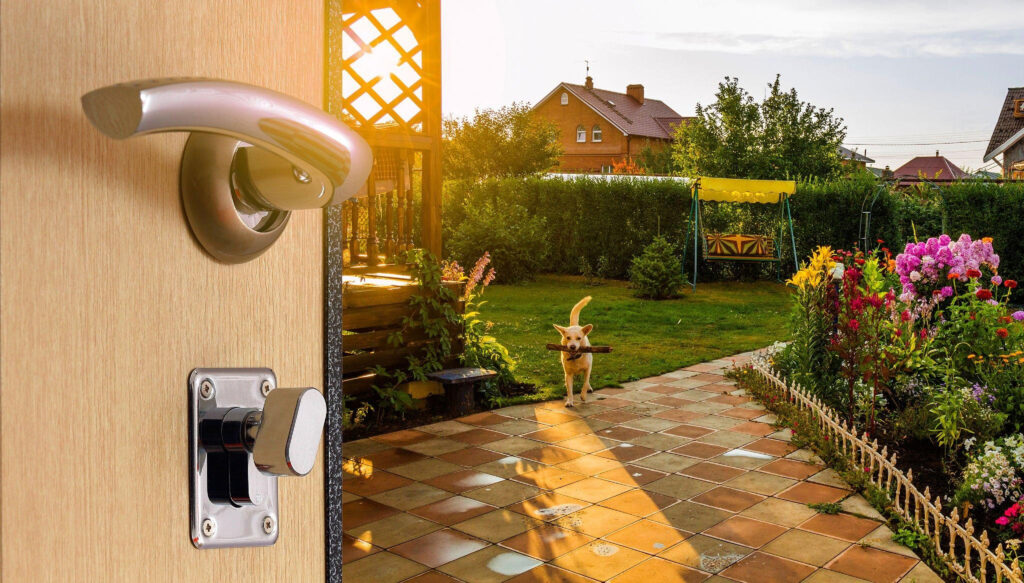
Key Takeaways on Affordable Fencing for Dogs
Fencing your yard enables dogs to play safely and freely at home. But with high materials and labor costs, installing a secure, quality barrier can get pricey. Use these budget-friendly tactics to contain pets without breaking the bank:
- Assess your needs – tailor the fence height, strength and layout to your dog’s size, energy and yard access. Don’t overbuild.
- Explore temporary affordable options like wire mesh to buy time.
- Opt for durable, economical permanent fencing like welded wire or chain link.
- Save hugely on materials by fencing just part of your yard strategically.
- Do it yourself with rented tools, help from friends and DIY guides to avoid hiring contractors.
- Compare estimates and shop sales, bulk discounts and cashback deals when buying supplies.
- Prioritize your dog’s safety – don’t cut corners just to save money.
- Maintain your fence proactively via repairs, tensioning, clearing vegetation and refinishing wood.
With smart planning and savvy shopping, you can install secure, long-lasting fencing tailored for your dog’s needs at a fraction of the cost. Protect your pet without breaking the bank by leveraging these budget-friendly techniques. Fencing doesn’t have to be a financial fence – get creative!
Frequently Asked Questions
What is the most cost-effective fencing for dogs?
Chain link and welded wire fencing provide the most security per dollar spent. They cost as little as $0.50-6 per linear foot.
What height fence is best for dogs?
4-6 feet is ideal for most dogs. Small breeds may only need 3 feet, while large/athletic dogs could require 8 feet.
How much does it cost to fence a yard for a dog?
On average, $1,500-4,000 depending on fencing material, height, and yard size. DIY installations can reduce costs substantially.
What is the cheapest temporary fencing for dogs?
Plastic mesh fencing rolls offer temporary confinement for $0.02 to $0.10 per linear foot. Snow fencing is another budget temporary option.
Can dogs dig under or climb over chain link fences?
Yes, which is why chain link alone may not contain motivated escape artists. Bury bottom edge or add chicken wire along base to thwart digging. Consider a fence topper to augment height.
How do I train my dog on a new fence?
Closely supervise initial weeks in a new fence. Use positive reinforcement and treats to reward calm behavior near perimeter. Discourage escape attempts and teach boundaries.
How often should I inspect my dog fence?
Inspect at least twice yearly – spring and fall. Also check after major storms for damage. Address any issues immediately before they worsen.
What are signs my fence needs repairs?
Look for loose wires or boards, cracked/leaning posts, rust spots, tunneling at base, sagging sections, and vegetative overgrowth. Make fixes right away.
How can I save money on DIY fence installation?
Rent tools, recruit friends to assist, take advantage of sales at home improvement stores, and use online tutorials. Avoid paying contractor markup. Remember we at Easywhy are always available to help you out.